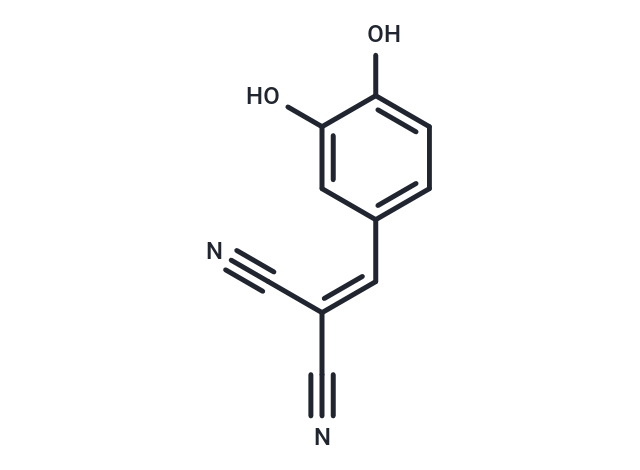Shopping Cart
- Remove All
 Your shopping cart is currently empty
Your shopping cart is currently empty

Tyrphostin 23 (AG18) inhibits EGFR with IC50 of 35 μM.

| Pack Size | Price | Availability | Quantity |
|---|---|---|---|
| 10 mg | $54 | In Stock | |
| 25 mg | $124 | In Stock | |
| 50 mg | $236 | In Stock | |
| 100 mg | $355 | In Stock | |
| 1 mL x 10 mM (in DMSO) | $36 | In Stock |
| Description | Tyrphostin 23 (AG18) inhibits EGFR with IC50 of 35 μM. |
| Targets&IC50 | EGFR:35 μM |
| In vivo | AG18 inhibits the volume-sensitive release of [3H] taurine in primary astrocyte cultures in a dose-dependent manner. Additionally, AG18 suppresses EGF-induced autophosphorylation of EGFR in A431 cells with an IC50 value of 15 μM and inhibits the proliferation of GH3 cells induced by EGF at a concentration of 10 μM. At the same concentration, AG18 also prevents the increase in ERK1/2 phosphorylation stimulated by Ghrelin in GH3 cells and counteracts 2xKCl-induced contractions, exerting maximal inhibitory effects. At 100 μM, AG18 blocks the activity of IKK stimulated by TNF-alpha and TPA in A549 epithelial cells. Furthermore, at a concentration of 300 μM, it dose-dependently inhibits the stimulation of ICAM-1 expression induced by TPA in A549 epithelial cells. Additionally, at this concentration, AG18 also hampers the TPA-stimulated NF-kappaB DNA-binding and ICAM-1 promoter activity in A549 epithelial cells. |
| Kinase Assay | EGF-Receptor Autophosphorylation: WGA-purified EGF receptor from A431 cells (0.5 μg/assay) is activated with EGF (800 nM) for 20 min at 4 ℃. The reaction is initiated by the addition of Mg(Ac)2 (60 mM), Tris-Mes buffer, pH 7.6 (50 mM), and [32P]ATP (20 pM, 5 μCi/assay). The reaction is conducted at either 4 ℃ or 15 ℃ and terminated by addition of sodium dodecyl sulfate (SDS) sample buffer (10% glycerol, 50 mM Tris, pH 6.8, 5% β-mercaptoethanol, and 3% SDS). The samples are run on a 8% SDS polyacrylamide gel (SDS-PAGE) (prepared from 30% acrylamide and 0.8% bis-(acrylamide) and contained 0.375 M Tris, pH 8.8, 0.1% SDS, 0.05% TEMED, and 0.46% ammonium persulfate). The gel is dried and autoradiography is perfromed with Agfa Curix RP2 X-ray film. The relevant radioactive bands are cut and counted in the Cerenkov mode. The fast phase of autophosphorylation continued for another 10 min. The extent of phosphorylation completed in the first 10 s at 15 ℃ comprises 1/3 of the total autophosphorylation signal and probably reflects the phosphorylation of the first site on the receptor. The 10-s interval is therefore chosen for use in subsequent autophosphorylation experiments. |
| Cell Research | GH3 cells are plated at 5 × 104 cells/well in media containing 2% charcoal-stripped FCS and various concentrations of ghrelin, desoctanoylated ghrelin and PMA or EGF for 72 hours with the addition of 2 μCi/well [3H]thymidine for a further 6 hours. A time-course of 24 hours, 48 hours and 72 hours is performed for ghrelin stimulation and 72 hours is selected for further experiments. Studies are also performed to investigate the effect of rat ghrelin or desoctanoyl ghrelin-induced proliferation and the effect of U0126, GF109203X, AG 18, wortmannin and H-89 upon ghrelin-induced MAPK stimulation. AG 18 at 10 μM is added 30 min before each treatment. Cells are harvested before counting in the presence of scintillation fluid using a Microbeta 1450 bcounter. Experiments are repeated at least three times.(Only for Reference) |
| Alias | Tyrphostin A23, TX 825, RG-50810, AG18 |
| Molecular Weight | 186.17 |
| Formula | C10H6N2O2 |
| Cas No. | 118409-57-7 |
| Smiles | Oc1ccc(C=C(C#N)C#N)cc1O |
| Relative Density. | 1.428 g/cm3 (Predicted) |
| Storage | Powder: -20°C for 3 years | In solvent: -80°C for 1 year | Shipping with blue ice. | |||||||||||||||||||||||||||||||||||
| Solubility Information | Ethanol: 35 mg/mL (188 mM), Sonication is recommended. H2O: < 1 mg/mL (insoluble or slightly soluble) DMSO: 35 mg/mL (188 mM), Sonication is recommended. | |||||||||||||||||||||||||||||||||||
Solution Preparation Table | ||||||||||||||||||||||||||||||||||||
Ethanol/DMSO
| ||||||||||||||||||||||||||||||||||||

Copyright © 2015-2025 TargetMol Chemicals Inc. All Rights Reserved.